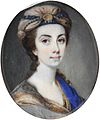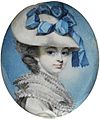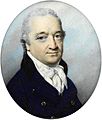George Engleheart facts for kids
George Engleheart (born 1750, died 1829) was a very famous English artist. He was known for painting small, detailed pictures called portrait miniatures. He lived at the same time as other great artists like Richard Cosway and John Smart.
Contents
George Engleheart's Family and Home Life
George Engleheart was likely born in Kew, Surrey, on October 26, 1750. His father, Francis Englehart, was a plaster modeller from Germany. He moved to England when he was a child. George's mother was Anne Dawney. He had seven brothers. The family name changed to Engleheart after his father passed away.
Marriages and Children
In 1776, George married his first wife, Elizabeth Brown. They lived in Prince's Street, Hanover Square, London. Sadly, Elizabeth died in 1779 when she was only 26 years old. Engleheart then moved to a new home in Mayfair, London.
He married his second wife, Ursula Sarah Browne, in 1785. They had four children together: George, Nathaniel, Harry, and Emma.
Retirement and Later Years
In 1813, Engleheart decided to retire fully to his country house. This house was in Bedfont, near Hounslow in Middlesex. He had bought the land for the house in 1783. The inside of his home was decorated in a popular style called neo-classical.
His second wife, Ursula, died in 1817. After this, Engleheart left his country house. He went to live with his son Nathaniel in Blackheath. Blackheath was a small village southeast of London at that time. George Engleheart passed away in Blackheath on March 21, 1829. He was buried at St. Anne's Church, Kew.
His nephew, John Cox Dillman Engleheart, also became a talented artist. He painted portrait miniatures during the Regency era.
George Engleheart's Art Career
Engleheart joined the new Royal Academy Schools on November 3, 1769. He learned from famous artists like George Barret and Sir Joshua Reynolds.
He started his own art business in 1773. He worked mostly in London throughout his career. From 1773 to 1822, he regularly showed his paintings at the Royal Academy.
His Fee Book and Many Paintings
Engleheart kept a detailed book from 1775 to 1813. In this book, he recorded his fees and drew small sketches of his miniatures. This special book is still owned by his family today.
He was a very busy artist! In 39 years, he painted an amazing 4,853 miniatures. His prices changed over time. In 1775, he charged 3 guineas for a painting. By 1811, his fee was 25 guineas. For many years, he earned more than £1,200 a year.
Engleheart mainly painted with watercolour on ivory. His work can be divided into three main periods.
Early Painting Style (around 1775)
His first paintings were quite small. Around 1775, artists often painted on tiny pieces of ivory, about 1.5 to 2 inches tall. Artists were still learning how to use watercolour on ivory. It was hard to make the paint stick to the smooth surface. This is why they kept the miniatures small. It was also popular for ladies to wear these tiny portraits on bracelets.
Engleheart sometimes signed his early portraits with 'G.E.' The skin in his paintings had reddish colours over a pale background. He used bluish-grey tones to make the facial features stand out.
Developing His Style (around 1780–1795)
During this time, Engleheart developed his unique style. His drawing skills and use of colour became very strong and consistent. He still painted some small miniatures. However, he more often used ivory pieces about 2.5 inches tall.
You can easily spot his work from this period. He often painted people with deep eyes under strong eyebrows. Their noses were slightly longer. The skin colour was a brownish-yellow tone. The corners of the mouth were drawn with diagonal grey lines.
Engleheart made his subjects look gentle, elegant, and calm. Even his military officers looked peaceful. He often used thick white paint to show details on the light-coloured dresses worn by women. Women's hair was often worn high or powdered, which was the fashion of the time. Men wore their hair powdered and tied back in a ponytail with a black ribbon.
He did not always sign his work during this period. But towards the end, he started signing with a cursive 'E' in the bottom corner. He also began to sign and date his portraits fully on the back.
Later Painting Style (around 1795–1813)
In the final period of his career, Engleheart's painting style stayed similar. However, his ivory pieces became larger, about 3 to 3.5 inches tall. The clothes in his paintings were much simpler. This was because of new fashion trends from France after the Revolution in 1789.
In Britain, powdered hair became less popular after 1795. The government put a tax of one guinea a year on people who wanted to wear hair powder or powdered wigs. This tax helped pay for the war with France. The fashions of this time are called the Regency style.
Men often dressed like country gentlemen. They wore plain navy blue or brown coats. They also wore white shirts with high collars and white cravats. Their hair was brushed forward, like the ancient Romans, and sometimes pushed up from the forehead.
Women wore empire line dresses in white muslin or coloured silk or satin. Their hair was usually worn up, with longer curls falling around the face. During this time, Engleheart taught two of his relatives, John Cox Dillman Engleheart and Thomas Richmond, how to paint miniatures.
As this final phase continued, Engleheart went back to signing his work with 'G.E.' He used either cursive letters or block capitals.
Engleheart painted King George III twenty-five times. He had many important customers, including almost everyone connected to the royal court. He also made careful miniature copies of famous paintings by Sir Joshua Reynolds. Sometimes, these copies are the only way we know about Reynolds's missing portraits. Engleheart's fee book, paints, tools, and a large collection of his miniatures are still owned by his family today.
George Engleheart's Friends
George Engleheart had many notable friends. These included the artist George Romney. He was also friends with William Blake, the famous poet and artist. Other friends were Jeremiah Meyer, who was also a portrait miniaturist, and William Hayley, a poet.
Examples of George Engleheart's Work







